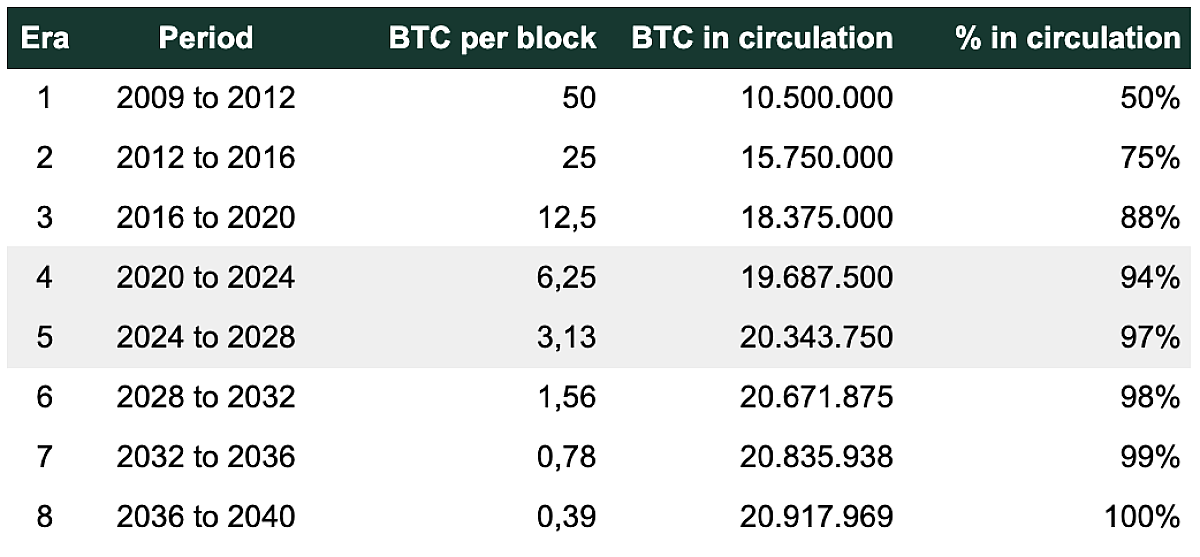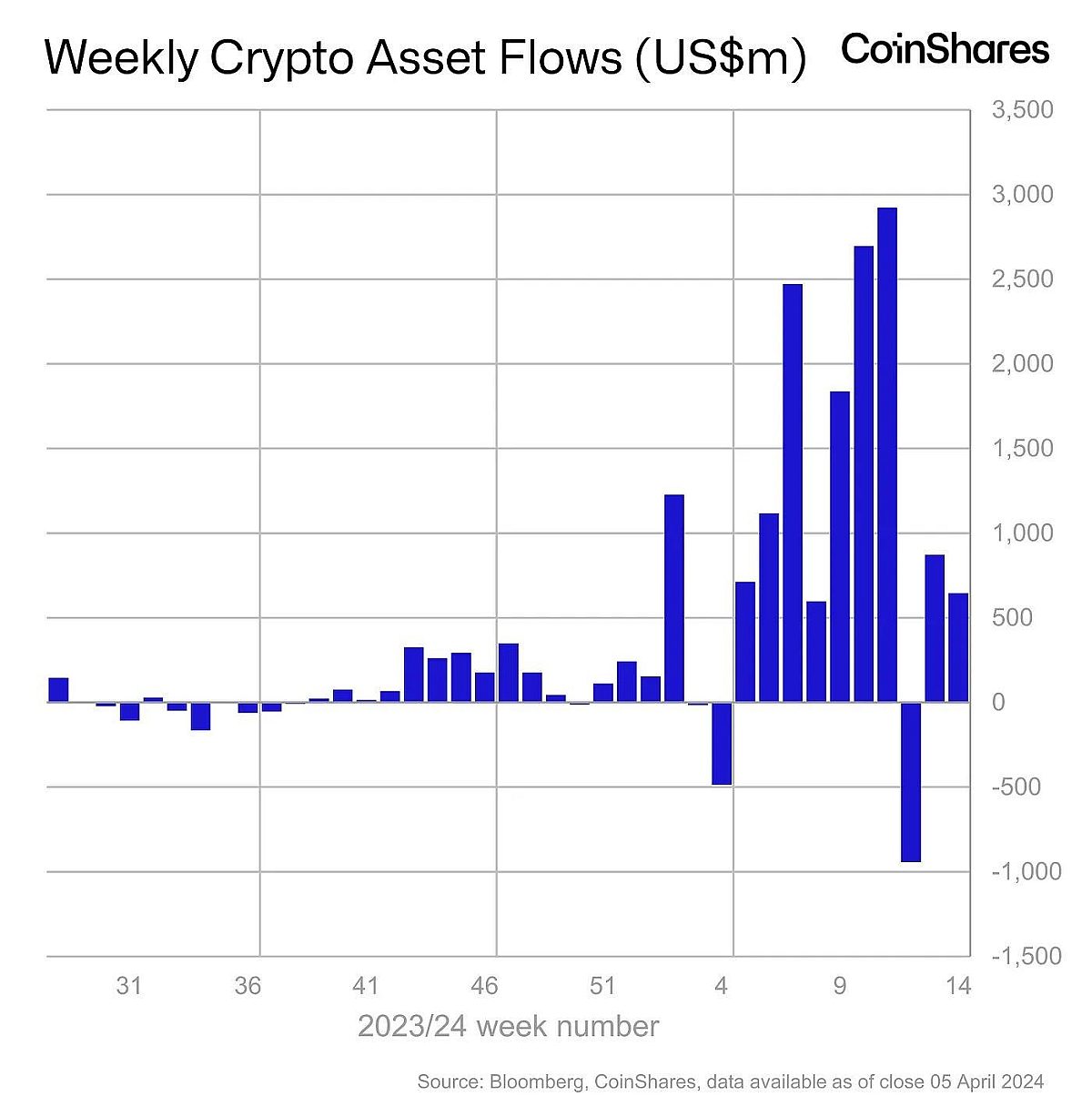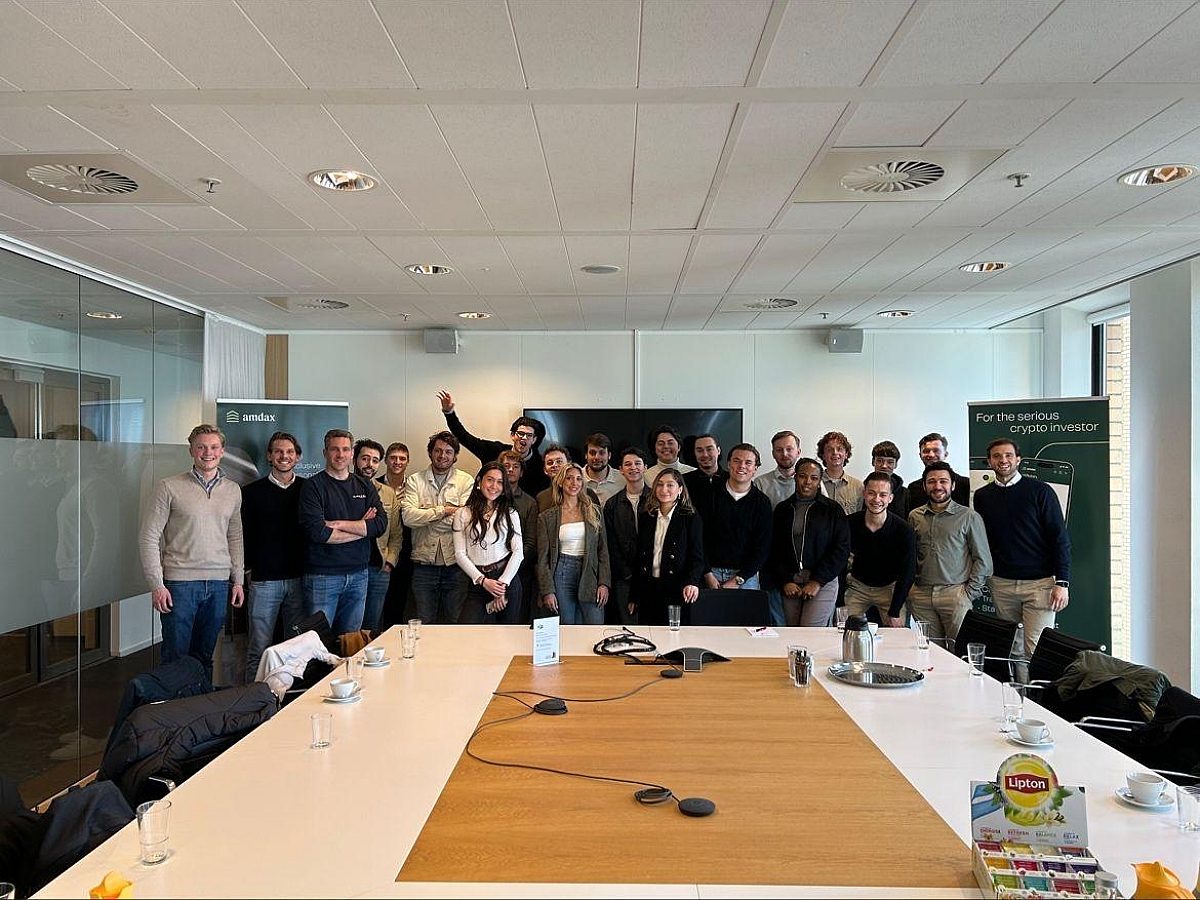What does the halving mean for Bitcoin?

10 April 2024
In about 10 days, Bitcoin will have an important, quadrennial event behind it. The so-called halving deeply impacts the earnings of Bitcoin miners. What does that mean for the Bitcoin market? And what impact does the halving have on the price of Bitcoin? All this, and more, you'll read in this Weekly!
This Weekly in brief
Market: The price is still sideways around $69,000, the peak of the previous bull market. A good moment to take a closer look at the Bitcoin halving that will take place next week.
News: The second quarter has just begun, and the crypto market has already set a new annual record. Never before has the inflow into crypto funds been so high. So far, nearly $14 billion has flowed in.
Behind the scenes: Last week, we welcomed the members of our partner SBAN (Student Blockchain Association Netherlands) to our office in Amsterdam. We'd love to tell you more about this successful knowledge-sharing afternoon!
Market update
Bitcoin's price has been hovering around $69,000 for about four weeks, the peak of the previous bull market. On March 14, we reached an all-time high of $73,800, and since then, the price has been sideways in a mild correction.
Such a correction is a healthy pause in a multi-year bull market. Investors have time to reconsider their positions. Some take profits, while others see holding prices around $70,000 as confirmation of their hypothesis and are expanding their positions.
The cooling of the market is evident in sentiment and figures. Trading volumes have decreased, as well as on-chain activity and inflows into ETFs. Even the volatility, the price movement, has decreased somewhat. This period of relative calm allows us to reflect on one of Bitcoin's characteristic three rhythms: the halving.
Let's start at the beginning. There are only 21 million bitcoins. More than that cannot be put into circulation unless an overwhelming majority of participants in the Bitcoin network agree to change the rules. But that's not in anyone's interest for the time being. The limited number and its immutability touch the core of what Bitcoin is for many. It's the numerical basis for Bitcoin as digital gold.
These 21 million bitcoins are brought into circulation according to a schedule predetermined by Satoshi Nakamoto. Every 210,000 blocks — about four years — half of what is not yet in circulation is released. Miners do this. They reward themselves with new bitcoins for securing the network with each block. They started with 50 bitcoins per block and halved to 25 and 12.5, reaching today's 6.25 bitcoins.
The next halving is scheduled for April 19 or 20. From that moment on, miners will bring 3.125 new bitcoins into circulation per block. For many Bitcoiners, this is a festive moment. A kind of New Year's Eve that comes around every four years. With a bonus of a positive effect on the price?

The 6.25 bitcoins per block add up to about 900 bitcoins per day. At the current price, that's 60 million euros. At the halving, this daily flow of new bitcoins will be halved. This means that 30 million euros less per day will be needed to buy these new bitcoins. Under unchanged conditions, the halving should therefore have a price-increasing effect.
Some analysts attribute Bitcoin's sensational bull markets, and consequently, the rest of the crypto market, to the halving. In the chart below, each halving seems to be the starting point for the subsequent rapid price increase. There is something to be said for this. With unchanged demand, the price must rise to sufficiently tempt existing investors to sell their Bitcoin, thereby offsetting the missing 450 bitcoins per day.
There are also counterarguments. That 450 bitcoins per day is only a fraction of what is traded in total. And there are more forces that move in a rhythm of roughly 3 to 4 years, such as liquidity in the global financial markets. In other words, the correlation between the market cycle of Bitcoin and the halvings could also be coincidental. How it will turn out in the fifth halving era? We'll know in four years!

News Overview
Every week, CoinShares reports on the inflow and outflow of crypto funds. The year 2021 was historic in this regard, with a total inflow of $10.6 billion. Historic, until 2024 arrived. We are already at a total inflow of $13.8 billion, the highest ever. And the second quarter has just begun.

Highlights of last week's report:
- $646 million flowed into crypto funds. We now look back on an impressive series of weeks with inflows of over $500 million.
- The majority of inflows go to Bitcoin products ($663 million). The contribution of parties betting against Bitcoin (via shorts) is decreasing.
- For the fourth consecutive week, money flowed out of Ether products. So far, investors seem reluctant to take a position in the number 2 crypto market.
- Investment products for other altcoins saw inflows. Solana (+$4M), Litecoin (+$4.4M), and Filecoin (+$1.4M) had positive weeks. Note, that these are relatively small amounts. These positions are relatively volatile.
If capital continues to flow into investment funds at this pace, the chance of setting a new annual record three times higher than the previous one is high!
💡 Crypto savings plan
Avoid buying at a high price at one point and spread your purchases over a longer period. This investment strategy is known as Dollar Cost Averaging (DCA). This spreads the risk and gives you peace of mind.
Want to buy crypto assets periodically and automatically? With the crypto savings plan, that's easy to set up. All you have to do is make sure there's enough balance in your account.

Other news:
- Ripple launches its dollar-pegged stablecoin. The as-yet-unnamed token will be backed by dollars, government bonds, and other cash equivalents. After launch, the token can be used on Ethereum and Ripple's network.
- Monthly trading volume on exchanges doubled in March. In total, traders generated nearly $2.5 trillion in trading volume. Spot ETFs also performed well: in March, $111 billion dollar worth of shares were traded, almost three times as much as in February.
- FTX plans to start repaying creditors by the end of this year. They have until May 15 to file a claim in one of the two bankruptcy proceedings (in the US or the Bahamas) and submit a claim.
Behind the scenes
Last week, we welcomed the members of our partner SBAN (Student Blockchain Association Netherlands) to our office in Amsterdam for a knowledge-sharing afternoon.
After lunch and a welcome speech by our CEO Lucas Wensing, the students had the opportunity to ask all their questions about crypto and blockchain to crypto experts Bert and Peter Slagter. The students then dispersed into various breakout sessions where case studies in the areas of IT & Product, Asset Management, and Legal & Compliance were discussed.
We look back on a successful afternoon, which concluded with a pleasant networking drinks session. Amdax is happy to contribute to the education of (among others) students in the field of crypto and blockchain. We enjoyed the enthusiasm and eagerness to learn from the SBAN members!

Always stay up to date?
Subscribe to the Amdax Weekly and receive a new Weekly in your mailbox every Wednesday.

Our website uses cookies
We use cookies to personalize content and advertisements, to offer social media features and to analyze our website’s traffic. We’ll also share information about your usage with our partners for social media, advertising and analysis. These partners can combine this data with data you’ve already provided to them, or that they’ve collected based on your use of their services.